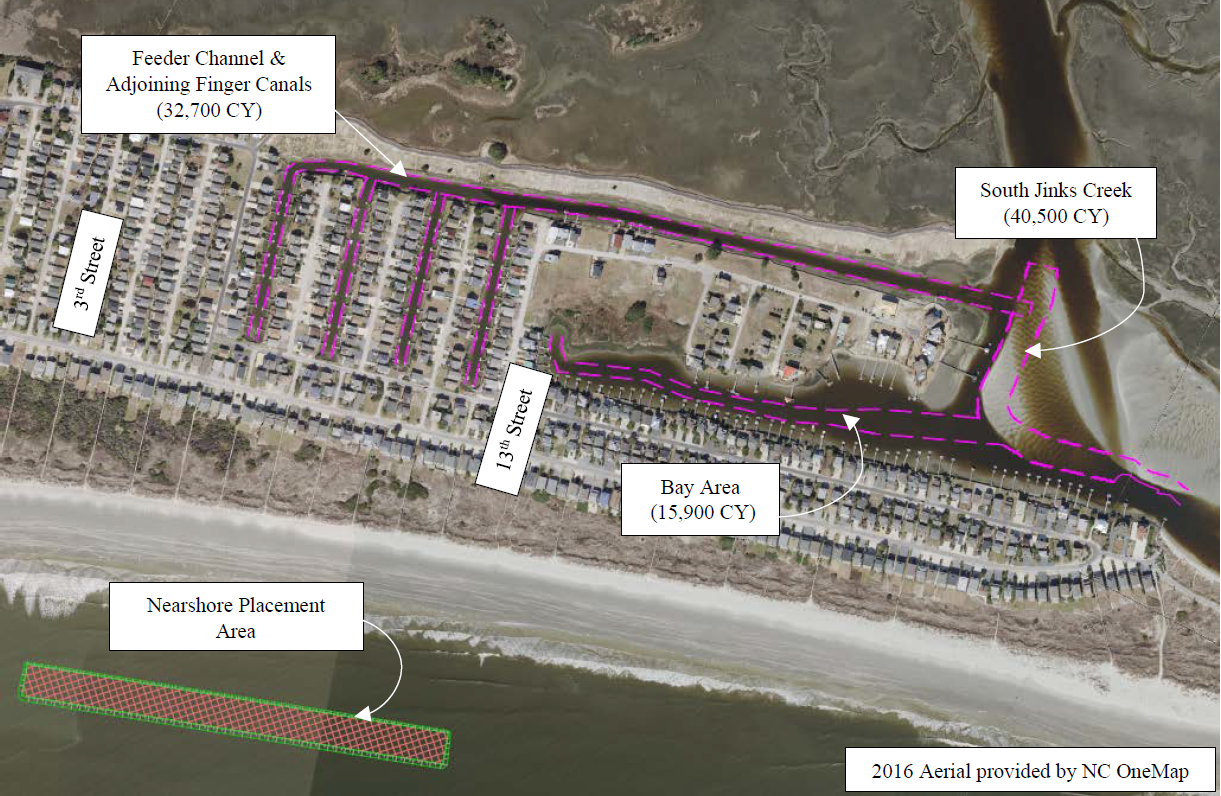
The state in February gave Sunset Beach the green light to pump material dredged from an ocean-access waterway onto a disposal site just off the beach, but two Sunset Beach property owners are challenging that permit.
The North Carolina Division of Coastal Management on Feb. 18 issued a major modification to the Coastal Area Management Act, or CAMA, major permit the town initially received in October 2019.
Supporter Spotlight
The modified permit grants the town the go-ahead to move an estimated 40,500 cubic yards of beach-compatible sand from South Jinks Creek to a nearshore area along about a 2,000-foot stretch of shoreline seaward between Third and 13th streets.
Residents Richard Hilderman and Rich Cerrato submitted to the division March 8 an application to appeal the permit. They argue that the town has not proven dredged sand placed in the nearshore site will remain within the shoal system from which it would be removed.
“The problem I have is there’s a CAMA regulation that says if you take spoils out, you must put it in the appropriate littoral system and it must remain in there permanently,” Hilderman said. “That’s the basis of my appeal, is you don’t have any evidence it’s going to remain in the Tubbs Inlet shoal system nor do you have any evidence that it will remain permanently there.”
He and Cerrato point specifically to a section of North Carolina General Statute Chapter 113 that reads “Clean, beach quality material dredged from navigational channels within the active nearshore, beach or inlet shoal systems shall not be removed permanently from the active nearshore, beach or inlet shoal system. This dredged material shall be disposed of on the beach or shallow active nearshore area where it is environmentally acceptable and compatible with other uses of the beach.”
Sunset Beach resubmitted permit applications to both the state and U.S. Army Corps of Engineers last October to put the dredged sand from South Jinks Creek in a new proposed location after beachfront property owners indicated they would refuse to grant the town property easements over concerns it might cost them “beachfront ownership.”
Supporter Spotlight
The town needed temporary construction easements under its original proposal to put equipment on private properties to move sand dredged from the creek onto a stretch of oceanfront between Fifth and 12th streets.
Shortly before the town asked the Corps to pull its original permit application in 2019, the federal agency sent the town a letter noting that the proposed oceanfront placement site was not eroding or in need of additional sand.
The town has indicated that while nearshore placement of material dredged from South Jinks Creek is a “last resort,” that option is an “environmentally acceptable and least cost alternative that meets the purpose and need of the project.”
The town is waiting on approval of its federal permit application from the Corps.
“Our office is still in the review process and haven’t completed our permit decision at this time,” Emily Winget, a public affairs specialist in the Corps’ Wilmington District, said in an email.
The modified state permit expires at the end of 2024.
About a decade ago, Sunset Beach officials began looking into maintenance dredging of the barrier island’s surrounding waterways, including Mary’s Creek and Turtle Creek, to improve and restore navigation access.
Dredging would help the town manage future development because it would create a pier head alignment that would allow the town to monitor future dock construction to ensure new piers would not impede navigation, according to town officials.
The town’s project includes dredging roughly 3 miles of waterway.
The original permit authorized the project with the condition that the maximum dredging depth be 2 feet below mean low water, which is consistent with a state rule prohibiting canals and boat basins from being dredged deeper than connecting waters.
About a year ago the Coastal Resources Commission, or CRC, granted a variance to the 2019 permit that allows the town to dredge about 18 acres, including South Jinks Creek, to a depth deeper than the connecting waters along its eastern border.
The variance allows dredging about 10,650 feet of South Jinks Creek, the bay area and the feeder channel, to a depth of no more than 6 feet below mean water. A series of finger canals would be dredged to 5 feet below mean low water.
A Division of Coastal Management spokesperson confirmed that the division had received two appeals to the CAMA permit on March 8.
Coastal Resources Commission Chair Renee Cahoon has 15 days from receiving the appeals to decide if the petitioners are entitled to a third-party hearing.
In order to get a hearing, a petitioner has to do the following: allege the permit contradicts a statute or rule; show that he or she is directly affected by the permit decision; and demonstrate the appeal is not frivolous.
According to information provided on the division’s website, if the commission chair grants a hearing, the petitioner may then file a petition for a contested case hearing in the Office of Administrative Hearings.
An administrative law judge will issue a final decision. The judge’s decision may be appealed to superior court.
The town’s website includes documents related to the project.







